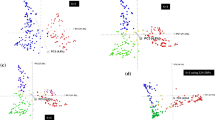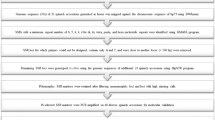Abstract
Key message
Sequence comparison between spelt and common wheat reveals that the former has huge potential in enriching the genetic variation of the latter.
Abstract
Genetic variation is the foundation of crop improvement. By comparing genome sequences of a Triticum spelta accession and one of its derived hexaploid lines with the sequences of the international reference genotype Chinese Spring, we detected variants more than tenfold higher than those present among common wheat (T. aestivum L) genotypes. Furthermore, different from the typical ‘V-shaped’ pattern of variant distribution often observed along wheat chromosomes, the sequence variation detected in this study was more evenly distributed along the 3B chromosome. This was also the case between T. spelta and the wild emmer genome. Genetic analysis showed that T. spelta and common wheat formed discrete groups. These results showed that, although it is believed that the spelt and common wheat are evolutionarily closely related and belong to the same species, a significant sequence divergence exists between them. Thus, the values of T. spelta in enriching the genetic variation of common wheat can be huge.





Similar content being viewed by others
References
Akhunov ED, Akhunova AR, Anderson OD, Anderson JA, Blake N et al (2010) Nucleotide diversity maps reveal variation in diversity among wheat genomes and chromosomes. BMC Genomics 11(1):702
An X, Li Q, Yan Y, Xiao Y, Hsam SLK et al (2005) Genetic diversity of European spelt wheat (Triticum aestivum ssp. spelta L. em. Thell.) revealed by glutenin subunit variations at the Glu-1 and Glu-3 loci. Euphytica 146(3):193–201
Avni R, Nave M, Barad O, Baruch K, Twardziok SO et al (2017) Wild emmer genome architecture and diversity elucidate wheat evolution and domestication. Science 357:93–97
Benson G (1999) Tandem repeats finder: a program to analyze DNA sequences. Nucleic Acids Res 27(2):573
Blatter RHE, Jacomet S, Schlumbaum A (2004) About the origin of European spelt (Triticum spelta L.): allelic differentiation of the HMW glutenin B1-1 and A1-2 subunit genes. Theor Appl Genet 108:360–367
Campbell KG (1997) Spelt: Agronomy, genetics, and breeding. Plant Breed Rev 15:187–213
Choulet F, Alberti A, Theil S, Glover N, Barbe V et al (2014) Structural and functional partitioning of bread wheat chromosome 3B. Science 345(80):1249721
Goettel W, Xia E, Upchurch R, Wang ML, Chen P et al (2014) Identification and characterization of transcript polymorphisms in soybean lines varying in oil composition and content. BMC Genomics 15(1):1
Guzmán C, Caballero L, Martín LM, Alvarez JB (2012) Waxy genes from spelt wheat: new alleles for modern wheat breeding and new phylogenetic inferences about the origin of this species. Ann Bot 110(6):1161–1171
Jordan KW, Wang S, Lun Y, Gardiner LJ, MacLachlan R et al (2015) A haplotype map of allohexaploid wheat reveals distinct patterns of selection on homoeologous genomes. Genome Biol 16(1):48
Kema GHJ (1992) Resistance in spelt wheat to yellow rust. III. Phytogenetical considerations. Euphytica 63:225–231
Langmead B, Salzberg SL (2012) Fast gapped-read alignment with Bowtie 2. Nat Methods 9(4):357–359
Li H, Handsaker B, Wysoker A, Fennell T, Ruan J et al (2009) The sequence alignment/map (SAM) format and SAMtools. Bioinformatics 25(16):2078–2079
Liu M, Stiller J, Holušová K, Vrána J, Liu D et al (2016) Chromosome-specific sequencing reveals an extensive dispensable genome component in wheat. Sci Rep 6:36398
Ma J, Li HB, Zhang CY, Yang XM, Liu YX et al (2010) Identification and validation of a major QTL conferring crown rot resistance in hexaploid wheat. Theor Appl Genet 120(6):1119–1128
Ma J, Yan GJ, Liu CJ (2012) Development of near-isogenic lines for a major QTL on 3BL conferring Fusarium crown rot resistance in hexaploid wheat. Euphytica 183(2):147–152
Ma J, Stiller J, Zhao Q, Feng Q, Cavanagh C et al (2014) Transcriptome and allele specificity associated with a 3bl locus for fusarium crown rot resistance in bread wheat. PLoS ONE 9(11):e113309
Ma J, Stiller J, Zheng Z, Liu YX, Wei Y et al (2015) A high-throughput pipeline for detecting locus-specific polymorphism in hexaploid wheat (Triticum aestivum L.). Plant Methods 11(1):39
MacKey J (1966) Species relationship in Triticum. Hereditas 2:237–276
McKenna A, Hanna M, Banks E, Sivachenko A, Cibulskis K et al (2010) The Genome Analysis Toolkit: a MapReduce framework for analyzing nextgeneration DNA sequencing data. Genome Res 20:1297–1303
Montenegro JD, Golicz AA, Bayer PE, Hurgobin B, Lee H et al (2017) The pangenome of hexaploid bread wheat. Plant J 90(5):1007–1013
Morris R. Sears ER (1967) The cytogenetics of wheat and its relatives. In: Quisenberry KS, Reitz LP (eds) Wheat and wheat improvement. Madison, pp 19–87
Murray MG, Thompson WF (1980) Rapid isolation of high molecular weight plant DNA. Nucleic Acids Res 8:4321–4326
Shewry PR, Hey S (2015) Do “ancient” wheat species differ from modern bread wheat in their contents of bioactive components? J Cereal Sci 65:236–243
Sobreira TJP, Durham AM, Gruber A (2006) TRAP: automated classification, quantification and annotation of tandemly repeated sequences. Bioinformatics 22(3):361–362
Acknowledgements
Work reported here was supported by the Commonwealth Scientific and Industrial Organization (CSIRO), Australia (Project code: R-10191-01), and a Chinese Academy of Sciences-CSIRO Joint Project (Project No. R-1910-1). ML is grateful to the Sichuan Agricultural University and the China Scholarship Council for funding his visit to CSIRO. JV, KH, and JD were supported by the Czech Ministry of Education, Youth and Sports (Award LO 1204 from the National Program of Sustainability I).
Author information
Authors and Affiliations
Corresponding authors
Ethics declarations
Conflict of interests
The authors declare that they have no conflict of interests.
Additional information
Communicated by Dr. Ling.
Electronic supplementary material
Below is the link to the electronic supplementary material.
Rights and permissions
About this article
Cite this article
Liu, M., Zhao, Q., Qi, F. et al. Sequence divergence between spelt and common wheat. Theor Appl Genet 131, 1125–1132 (2018). https://doi.org/10.1007/s00122-018-3064-z
Received:
Accepted:
Published:
Issue Date:
DOI: https://doi.org/10.1007/s00122-018-3064-z




